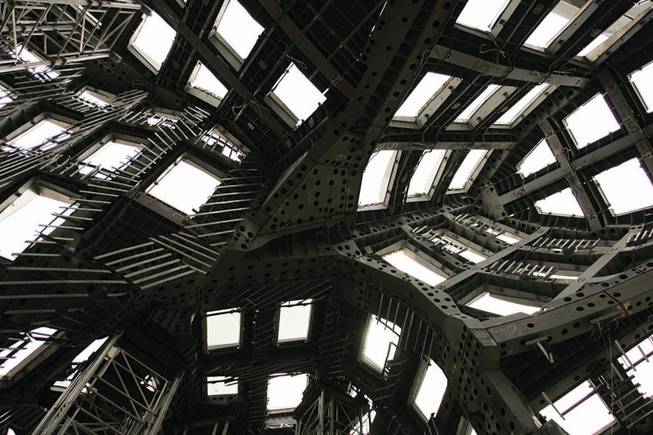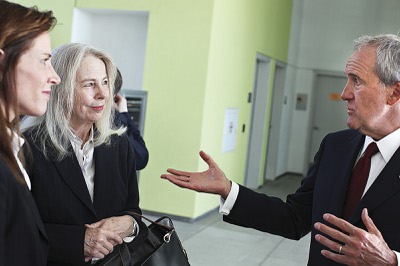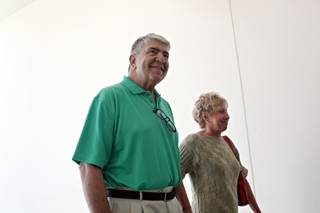
Frank Gehry’s design for the Cleveland Clinic Lou Ruvo Center for Brain Health is taking shape in downtown Las Vegas. Many of the architect’s friends are artists, and some have agreed to offer works for display and sale at the center for its fundraising.
Saturday, July 18, 2009 | 2 a.m.

Libby Lumpkin, center, who has been hired to amass and curate the rotating art exhibit at the brain center, chats with Maureen Peckman, left, chief operating officer of Keep Memory Alive, the center's fundraising arm, and Larry Ruvo, the center's founder. Lumpkin was executive director of the Las Vegas Art Museum.
Sun Archives
- Why Ruvo's a sight to see -- right now (7-10-2009)
- Ruvo’s mission is bold, driven by love (2-17-09)
- Ruvo’s dream becomes real (2-17-09)
- Gehry's design elevates awareness of Alzheimer's disease, research (2-17-09)
- In Cleveland, patients are priority (2-17-09)
- Aiming to revolutionize dementia research (1-7-2009)
- Brain institute thinking big (12-24-3008)
- Six-figure donation to be used to fight brain diseased (1-28-2008)
- With Lumpkin's exit, museum must be 'creative' to survive, interim director says (12-5-2008)
- Chief who set new course for LVAM is out, suddenly (12-3-2008)
- Museum gift shop will be missed, but it’s gone for good reasons (12-3-2008)
Sun Coverage
Lou Ruvo Brain Institute
The Cleveland Clinic Lou Ruvo Center for Brain Health has hired Libby Lumpkin, former executive director of the Las Vegas Art Museum, to amass and curate a rotating art exhibition.
The art will be displayed at the center, and visitors will pay admission to view the work, which will also be for sale, said Larry Ruvo, who founded the center in honor of his father. Proceeds of admissions and sales will be funneled back into the institution and its clinical care and medical research.
The program adds to the high-end credentials of the clinic being built in downtown’s Symphony Park: building by Frank Gehry, acoustics by Yasuhisa Toyota, food by Wolfgang Puck and now, museum-quality works by some of the top names in contemporary art.
Neither Lumpkin nor Ruvo would say which artists will be represented in the collection, but Lumpkin did say many are friends of Gehry’s and that they are among the most “outstanding contemporary masters living today.”
Work by some of the artists has appeared in two Las Vegas Art Museum exhibits, “Southern California Minimalism” and “Las Vegas Collects.” Among the artists included in those exhibitions were James Turrell, John McCracken, Larry Bell, Craig Kauffman, Ron Davis, Peter Alexander, Robert Irwin, Ed Ruscha, David Hockney and Donald Judd.
Ruvo came up with the idea after several artists expressed interest in having their works in the building. The art program is designed to get people through the doors and give them an opportunity to learn about brain diseases.
“Now there’s an added reason to come inside and not just take pictures outside,” Ruvo said.
Lumpkin, an art historian who curated Steve Wynn’s collection at the Bellagio Gallery of Fine Art, helped bring cutting-edge contemporary art to the Las Vegas Art Museum before resigning because of budget tightening. The museum closed three months later.
Lumpkin began working for the Ruvo Center this month and has been asking artists to participate in the program. Works by Gehry will also be on display and for sale at the center.
Gehry is known as an architect who pals around with artists, rather than other architects. Many of those relationships were established in Venice, Calif., during the 1960s and ’70s.
In 2005 Gehry curated an exhibit, “The Artists of Venice Beach 1962-1978,” at the Weisman Art Museum, a building in Minneapolis that he designed. The exhibit featured the work of 16 artists whose work influenced his early career.
Lumpkin said the artists’ response has been positive: “They’ll say, ‘My mother has Parkinsons, my father has Alzheimer’s. I want to do something.’
“Also, this building and this center are personally important to Frank Gehry.”
Gehry is associated with the Hereditary Disease Foundation, which seeks a cure for Huntington’s disease and other genetic illnesses.
Lumpkin’s expertise in contemporary art and the complexities of art installation, and her relationships with artists, will enable the center to obtain works by quality artists, Ruvo said. Frank Gehry’s name, building and relationships with artists are also key: “It’s very exciting to be leveraging Frank’s friends and resources. He has an amazing group of artist friends.”
Ruvo said that he is impressed with what “Frank did with Jeff Koons in Bilbao,” referring to Koons’ enormous floral puppy installed outside the museum, and that he would love to see a Koons at the Ruvo Center.
Other health institutions have incorporated fine art into the patient and public areas of their buildings, including the Cleveland Clinic, which has more than 3,500 works of contemporary and modern art in its collection, which hangs in the institute. Cleveland Clinic has a healing through art program.
The Nevada Cancer Institute also has a permanent contemporary art collection on display in public areas and in patient rooms.
Using art to better understand brain diseases is being studied by the New York University School of Medicine in partnership with the Museum of Modern Art through its Meet Me at MoMA program. The program, launched in 2006, welcomes patients in early and middle stages of Alzheimer’s into the museum for tours and to engage in dialogue.
Though some institutes have art in their collections that is auctioned off, the Ruvo art program is unique in that the main purpose of the art program is to raise money for the institution. The activities center and convention hall at the Ruvo Center is also designed to raise money. The space will be used for conventions and private party rentals.
Lumpkin says she’s pleased to be associated with the project: “You can hate art. You can hate art museums, but nobody can argue the need for the cure for these diseases.”


Join the Discussion:
Check this out for a full explanation of our conversion to the LiveFyre commenting system and instructions on how to sign up for an account.
Full comments policy